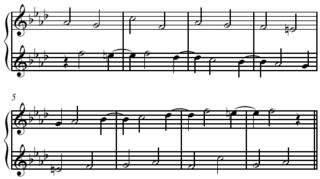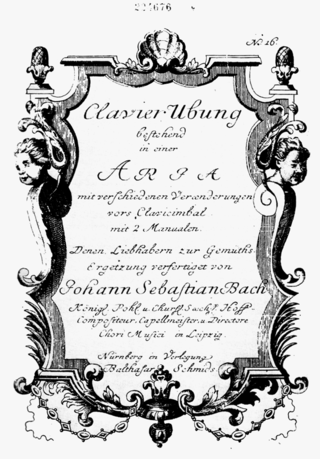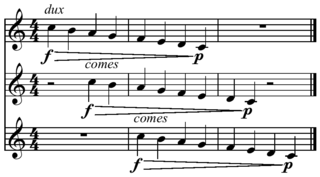
In music, counterpoint is a method of composition in which two or more musical lines are simultaneously played which are harmonically correlated yet independent in rhythm and melodic contour. It has been most commonly identified in the European classical tradition, strongly developing during the Renaissance and in much of the common practice period, especially in the Baroque period. The term originates from the Latin punctus contra punctum meaning "point against point", i.e. "note against note".

In classical music, a fugue is a contrapuntal, polyphonic compositional technique in two or more voices, built on a subject that is introduced at the beginning in imitation, which recurs frequently throughout the course of the composition. It is not to be confused with a fuguing tune, which is a style of song popularized by and mostly limited to early American music and West Gallery music. A fugue usually has three main sections: an exposition, a development, and a final entry that contains the return of the subject in the fugue's tonic key. Fugues can also have episodes—parts of the fugue where new material is heard, based on the subject—a stretto, when the fugue's subject "overlaps" itself in different voices, or a recapitulation. A popular compositional technique in the Baroque era, the fugue was fundamental in showing mastery of harmony and tonality as it presented counterpoint.

Gödel, Escher, Bach: an Eternal Golden Braid, also known as GEB, is a 1979 book by Douglas Hofstadter.

A crab canon is an arrangement of two musical lines that are complementary and backward. If the two lines were placed next to each other, the lines would form something conceptually similar to a palindrome. The name 'crab' refers to the fact that crabs are known to walk backward. It originally referred to a kind of canon in which one line is played backward. An example is found in J. S. Bach's The Musical Offering, which also contains a table canon, which combines retrogression with inversion by having one player turn the music upside down.

The Goldberg Variations, BWV 988, is a musical composition for keyboard by Johann Sebastian Bach, consisting of an aria and a set of 30 variations. First published in 1741, it is named after Johann Gottlieb Goldberg, who may also have been the first performer of the work.

The Book of Kells is an illuminated manuscript and Celtic Gospel book in Latin, containing the four Gospels of the New Testament together with various prefatory texts and tables. It was created in a Columban monastery in either Ireland or Scotland, and may have had contributions from various Columban institutions from each of these areas. It is believed to have been created c. 800 AD. The text of the Gospels is largely drawn from the Vulgate, although it also includes several passages drawn from the earlier versions of the Bible known as the Vetus Latina. It is regarded as a masterwork of Western calligraphy and the pinnacle of Insular illumination. The manuscript takes its name from the Abbey of Kells, County Meath, which was its home for centuries.

Giovanni Battista or Giambattista Martini, O.F.M. Conv., also known as Padre Martini, was an Italian Conventual Franciscan friar, who was a leading musician, composer, and music historian of the period and a mentor to Mozart.

The Art of Fugue, or The Art of the Fugue, BWV 1080, is an incomplete musical work of unspecified instrumentation by Johann Sebastian Bach. Written in the last decade of his life, The Art of Fugue is the culmination of Bach's experimentation with monothematic instrumental works.

In music, a canon is a contrapuntal (counterpoint-based) compositional technique that employs a melody with one or more imitations of the melody played after a given duration. The initial melody is called the leader, while the imitative melody, which is played in a different voice, is called the follower. The follower must imitate the leader, either as an exact replication of its rhythms and intervals or some transformation thereof. Repeating canons in which all voices are musically identical are called rounds—familiar singalong versions of "Row, Row, Row Your Boat" and "Frère Jacques" that call for each successive group of voices to begin the same song a bar or two after the previous group began are popular examples.

Costanzo Festa was an Italian composer of the Renaissance. While he is best known for his madrigals, he also wrote sacred vocal music. He was the first native Italian polyphonist of international renown, and with Philippe Verdelot, one of the first to write madrigals, in the infancy of that most popular of all sixteenth-century Italian musical forms.
The Toccata and Fugue in F major, BWV 540, is an organ work written by Johann Sebastian Bach, potentially dating from the composer's time in Weimar, or in Leipzig.
In music, voice crossing is the intersection of melodic lines in a composition, leaving a lower voice on a higher pitch than a higher voice. Because this can cause registral confusion and reduce the independence of the voices, it is sometimes avoided in composition and pedagogical exercises.
In music theory, an inversion is a rearrangement of the top-to-bottom elements in an interval, a chord, a melody, or a group of contrapuntal lines of music. In each of these cases, "inversion" has a distinct but related meaning. The concept of inversion also plays an important role in musical set theory.
Charles Herbert Kitson was an English organist, teacher, and music educator, author of several books on harmony and counterpoint.

The Canonic Variations on "Vom Himmel hoch da komm' ich her", BWV 769, are a set of five variations in canon for organ with two manuals and pedals by Johann Sebastian Bach on the Christmas hymn by Martin Luther of the same name. The variations were prepared as a showpiece for Bach's entry as fourteenth member of Mizler's Music Society in Leipzig in 1747. The original printed edition of 1747, in which only one line of the canon was marked in the first three variations, was published by Balthasar Schmid in Nuremberg. Another version BWV 769a appears in the later autograph manuscript P 271, which also contains the six trio sonatas for organ BWV 525–530 and the Great Eighteen Chorale Preludes BWV 651–668. In this later version Bach modified the order of the variations, moving the fifth variation into a central position, and wrote out all the parts in full, with some minor revisions to the score.
These [variations] are full of passionate vitality and poetical feeling. The heavenly hosts soar up and down, their lovely song sounding out over the cradle of the Infant Christ, while the multitude of the redeemed "join the sweet song with joyful hearts." But the experiences of a fruitful life of sixty years have interwoven themselves with the emotions which possessed him in earlier years ... The work has an element of solemn thankfulness, like the gaze of an old man who watches his grandchildren standing round their Christmas tree, and is reminded of his own childhood.
The brilliant scale passages not only represent the ascending and descending angels, but sound joyous peals from many belfries ringing in the Saviour's birth.
Thamphthis is the hellenized name of an ancient Egyptian ruler (pharaoh) of the 4th Dynasty in the Old Kingdom, who may have ruled around 2500 BC under the name Djedefptah for between two and nine years. His original Egyptian name is lost, but it may have been Djedefptah or Ptahdjedef according to William C. Hayes. Thamphthis is one of the shadowy rulers of the Old Kingdom, since he is completely unattested in contemporary sources. For this reason, his historical figure is discussed intensely by historians and Egyptologists.
A biblical canon is a set of texts which a particular Jewish or Christian religious community regards as part of the Bible.

Mit Fried und Freud, BuxWV 76, is the common name for a piece of funeral music composed by Dieterich Buxtehude as an homage to his father in 1674. The composer named the work Fried- und Freudenreiche Hinfarth when he published it the same year. It is a bundle of two compositions, the earlier Mit Fried und Freud, BuxWV 76a, a setting of Luther's hymn Mit Fried und Freud ich fahr dahin composed in 1671 reflecting the death of Menno Hanneken, and the elegy Klag-Lied, BuxWV 76b, an aria in seven stanzas. The incipit of the elegy, "Muß der Tod denn auch entbinden", translates roughly to "Even if death must separate us". It is one of few compositions published during Buxtehude's lifetime.

Geistliches Lied, Op. 30, by Johannes Brahms is an 1856 work for four-part mixed chorus accompanied by organ or piano. The composition is in the form of a double canon set to text by Paul Flemming. It was written as part of an exchange of contrapuntal exercises between Brahms and Joseph Joachim, and it was eventually published in 1864.













